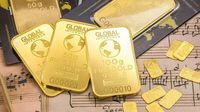Gold prices in India experienced significant fluctuations on April 4, 2025, as they fell by ₹17,400 per 100 grams after a period of relentless price surges that had seen gold reach historic highs. This dramatic drop comes as a relief for buyers and investors who have been anxious about the continuously rising gold rates, which had been fueled by recent geopolitical tensions and economic uncertainties.
According to various reports, on April 4, the price of 24-carat gold in India dropped to ₹91,640 per 10 grams, reflecting a decline of ₹1,740. This decrease followed a previous 2% drop triggered by U.S. President Donald Trump's announcement of reciprocal tariffs on imports, which rattled global equity and commodity markets. Gold is often viewed as a safe-haven asset during uncertain times, but the recent tariff measures have added a layer of complexity to its pricing.
In major Indian cities, the gold prices varied slightly. In Delhi, the price of 18-carat gold was ₹7,016 per gram, while the 22-carat gold was priced at ₹8,576 per gram, and 24-carat gold at ₹9,354 per gram. Similarly, in Mumbai, 18-carat gold was at ₹7,004 per gram, with 22-carat gold at ₹8,561 and 24-carat at ₹9,339. Bangalore saw the same prices for 18-carat and 22-carat gold as Mumbai, while Chennai reported 18-carat gold at ₹7,060, 22-carat at ₹8,561, and 24-carat at ₹9,339.
As of 03:05 GMT on April 4, spot gold was reported down 0.5% to $3,097.99 an ounce, having reached a record high of $3,167.57 earlier in the week. The fluctuations in gold prices are often closely tied to global market conditions, and the recent tariff announcements have caused a ripple effect across various sectors. Ilya Spivak, Head of Global Macro at Tastylive, noted, "Gold tends to rally amid difficult-to-price uncertainty—like the start of a war—but tends to lose that support once markets learn how to price the risks involved."
The market remains divided on the future of gold prices. Some analysts, like Sandip Raichura, CEO of PL Broking, maintain that the bullish undertone for gold remains strong despite the recent pullback. Raichura stated, "Gold has touched new record highs of $3,172 per ounce in line with our earlier projections. But it’s now trading above a rising channel, which may be a signal of caution. Reversals can be sharp, so tight stop losses are essential."
On the other hand, some experts express caution, warning that if inflation continues to rise and the Federal Reserve delays rate cuts, gold may face renewed downside pressure in the first half of 2025. Market projections for gold remain varied, with HSBC recently raising its average gold price forecast to $3,015 per ounce for 2025 and $2,915 per ounce for 2026, citing ongoing geopolitical tensions and economic instability.
In addition to gold, silver prices also saw a decline, with 1 kg of silver in India costing ₹99,000, down by ₹4,000, while 100 grams of silver retailed at ₹9,900 after a drop of ₹400. This decline in silver prices reflects broader trends in precious metals, which are often influenced by similar market dynamics.
As gold futures traded on the MCX for June 5 contracts fell by 0.59% to ₹89,524 per 10 grams, market analysts are advising caution for investors. Rahul Kalantri, VP of Commodities at Mehta Equities, highlighted that gold has support levels at $3,072–3,040 per ounce and resistance at $3,112–3,135 per ounce. In rupee terms, gold support is noted at ₹89,960–89,350, with resistance at ₹90,710–90,990.
Manoj Kumar Jain of Prithvifinmart Commodity Research echoed similar sentiments, suggesting that traders should wait for some stability in the markets before making new positions. Jain indicated that the current volatility in the dollar index and the ongoing global trade war are likely to keep gold and silver prices fluctuating in the near term.
Despite the current market fluctuations, gold continues to hold significant value as a hedge against economic stress. Investors are advised to monitor market conditions closely and consider protective measures, particularly in the face of potential volatility. As the global economy navigates through these uncertain times, the outlook for gold and other precious metals remains a topic of keen interest among investors and analysts alike.
In summary, the gold market is currently experiencing a notable correction after a period of unprecedented highs, influenced by a combination of global economic factors and domestic demand. As the situation evolves, both short-term traders and long-term investors will need to remain vigilant and adaptable to the changing landscape of precious metals.







